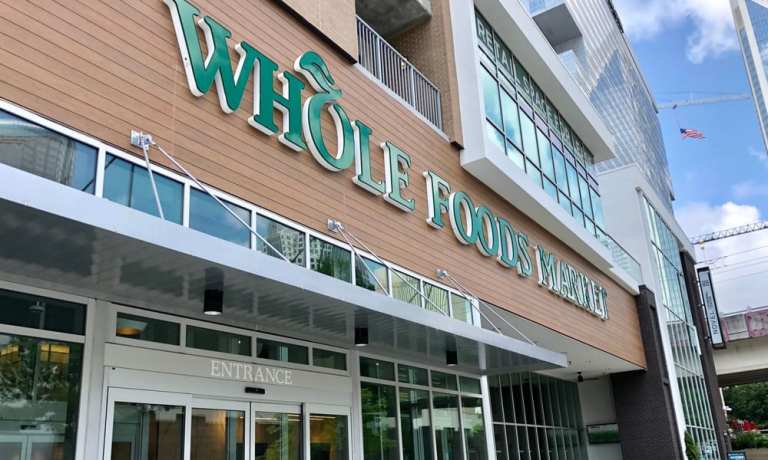This week was the calm before the storm in the battle for the U.S. consumer’s whole paycheck. Both Amazon and Walmart are busy prepping for what could be the biggest shopping week of the year, as Prime Day and various other events will reach consumers starting Tuesday (Oct. 13) and running basically through to Thanksgiving.
But there was plenty of noise on another front.
Several reports late in the week are spelling trouble for Amazon’s Whole Foods. PYMNTS has its own data on the high-end grocery chain – but first, let’s get into the reports that spawned headlines like Bloomberg’s “Does Amazon Even Care About Whole Foods Anymore?”
Yes, it might sound like crazy talk – but it gets clicks. Of course, Amazon cares about Whole Foods. But there’s also some evidence that foot traffic and sales at the chain are down. Trips to Whole Foods in September were down 25 percent from a year earlier, according to Placer.ai, which gathers estimates of retail foot traffic from about 30 million mobile devices. That number follows a 22 percent drop year over year for August. But before running to sell Amazon stock for its impending doom, look at Placer’s report about the overall grocery category.
“The first key metric to analyze is overall visits, and few sectors have seen the same general positive trend as grocery,” says its blog. “For the week beginning Aug. 17, the wider grocery sector was still down 5.3 percent overall. Yet, much of this was the result of a few outliers that were still seeing significant declines. Instead, the wider picture does look to be very positive for the space.
“Of the eight brands analyzed, only three saw year-over-year declines in August 2020. While two of those, Wegmans and Sprouts, were within striking distance of year-over-year growth, Whole Foods was still down 22.5 percent year over year in August. But critically, even Whole Foods was enjoying a strong recovery that was consistently pulling visit rates higher each month. And this is a powerful context for a sector that could be well-positioned for the months to come.”
Advertisement: Scroll to Continue
According to other reports, including a good look from The Philadelphia Inquirer, some of the decline is due to consumers consolidating shopping trips and buying more groceries online. That “consolidation of trips” would speak to better results for retailers like Target and Walmart, which often have grocery items stacked with general merchandise. Bloomberg even speculated that Amazon was more enamored with and focused on its Amazon Fresh venture, which had seen some high-profile openings in New York City and Los Angeles.
“The debut of the Fresh store, in particular, set off alarm bells (within Whole Foods),” said Bloomberg. “The early price cuts at Whole Foods suggested Amazon was trying to erase its ‘whole paycheck’ reputation and make the chain appeal to a wider swath of consumers. The Amazon Fresh concept seems like a concession that Amazon is not going to be able to turn Whole Foods into an everyman’s grocer. Or, worse, the concept could be a sign that Amazon is flooding the zone with grocery offerings that simply cannibalize one another’s business.”
The truth about Whole Foods might be that it simply can’t keep pace with the exponential growth of its parent company. It’s also possible that the categories it caters to aren’t built for the same kind of increases.
For example, let’s look at the food and beverage category. According to data from PYMNTS’ exclusive Whole Paycheck Tracker, food and beverage for Amazon’s gross sales (Whole Foods is not broken out) hardly budged from Q2 2019 to Q2 2020. Last year, the quarter showed a $5.5 billion take for food and beverage. This year, despite huge leaps in overall revenue for Amazon, it only increased to $5.6 billion. Most, if not all, of that increase came from digital sales, as the eCommerce breakout for the category showed a jump from $1.2 billion to $1.9 billion. It is easily Amazon’s lowest eCommerce category, $1 billion behind auto parts. Not exactly an earnings call highlight.
However, other evidence from PYMNTS’ analysis does show a drop at Whole Foods. Amazon’s physical store revenue (mainly Whole Foods) dropped almost 13 percent from $4.6 billion in Q1 2020 to $3.7 billion in Q2. It could be a result of those consolidated shopping trips during the pandemic, or it could be due to consumers shying away from spending money at a supermarket known more for its organic foods than its staples. Q2 2019 was still much higher than 2020, coming in at $4.3 billion.
In an emailed statement to The Inquirer, a Whole Foods spokeswoman said: “Whole Foods Market continues to grow, and we strongly dispute this portrayal of the health of our business. In addition to offering a safe in-store shopping experience, we’re proud we’ve been able to rapidly expand grocery delivery and pickup to meet the needs of customers.”




